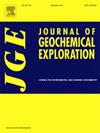锂-铯-钽(LCT)型伟晶岩矿物系统建模:伊朗西部Sanandaj-Sirjan地区区域尺度勘探目标与不确定性分析
IF 3.3
2区 地球科学
Q1 GEOCHEMISTRY & GEOPHYSICS
引用次数: 0
摘要
花岗质伟晶岩,特别是锂铯钽(LCT)类型,是稀有金属的重要来源,对现代技术至关重要,包括可持续性、能源储存和绿色能源应用。探索和定位LCT伟晶岩对于满足绿色技术对锂等关键金属日益增长的需求至关重要。矿产远景建模提供了一种系统的方法来识别这些矿床,特别是在伊朗西部地区,那里的Sanandaj-Sirjan带(SaSZ)是LCT伟晶岩的潜在宿主。本研究旨在模拟SaSZ LCT伟晶岩的前景,主要有三个目标:(1)构建一个矿产系统框架,定义控制LCT伟晶岩成因的关键过程及其可映射代理;(2)使用知识驱动的方法确定高优先级勘探目标;(3)解决有限数据可用性(认知)和多模型集成(系统)带来的不确定性,以提高勘探可靠性。为了实现这些目标,三种著名的基于知识的算法——模糊推理系统、连续模糊伽玛和几何平均——使用公开可用的地质勘探数据集来生成基于矿物系统方法的远景模型。随后使用多数投票(MV)集成技术将这些组合成最终的预测模型。采用置信指数(CI)来量化和减轻与多算法方法相关的不确定性,为未来的勘探划定低风险、高可信度的区域。结果表明,该区北部和南部有高找矿带(约占研究区面积的2%),特别是在阿尔万杂岩体附近,主要位于远离其主岩体和变质光环内。该研究强调了将矿产系统框架与地理空间建模相结合以优化勘探策略的有效性。未来的研究应优先获取高分辨率的地球物理和地球化学数据,并进行系统的地面真相调查,以验证和完善这些目标,确保经济可行性和资源效率。本文章由计算机程序翻译,如有差异,请以英文原文为准。
Mineral system modeling of Lithium-Cesium-Tantalum (LCT)-type pegmatites: Regional-scale exploration targeting and uncertainty analysis in the Sanandaj-Sirjan zone, Western Iran
Granitic pegmatites, particularly lithium‑cesium‑tantalum (LCT) types, are vital sources of rare metals crucial for modern technologies, including sustainability, energy storage, and green energy applications. Exploring and targeting LCT pegmatites are essential to meet the increasing demand for critical metals like lithium in green technologies. Mineral prospectivity modeling provides a systematic approach to identifying these deposits, especially in regions such as western Iran, where the Sanandaj-Sirjan Zone (SaSZ) is the potential host of LCT pegmatites. This study aims to model the prospectivity of LCT pegmatites in the SaSZ, with three primary objectives: (i) to construct a mineral systems framework that defines the critical processes controlling the genesis of LCT pegmatites and their mappable proxies, (ii) to identify high-priority exploration targets using knowledge-driven approaches, and (iii) address uncertainties stemming from limited data availability (epistemic) and from the integration of multiple models (systemic) to improve exploration reliability. To achieve these objectives, three well-known knowledge-based algorithms—fuzzy inference systems, continuous fuzzy gamma, and geometric average—were employed using publicly available geo-exploration datasets to generate prospectivity models based on the mineral systems approach. These were subsequently combined into a final predictive model using a majority voting (MV) ensemble technique. A confidence index (CI) was incorporated to quantify and mitigate uncertainties associated with the multi-algorithm approaches, delineating low-risk, high-confidence zones for future exploration. The results show high prospectivity zones (~2 % of the study area) in the northern and southern parts of the SaSZ, particularly near the Alvand complexes, predominantly located farther from their host plutons and within metamorphic aureoles. This study highlights the efficacy of integrating mineral systems frameworks with geospatial modeling to optimize exploration strategies. Future research should prioritize acquiring high-resolution geophysical and geochemical data and conducting systematic ground-truthing to validate and refine these targets, ensuring economic feasibility and resource-efficient exploration.
求助全文
通过发布文献求助,成功后即可免费获取论文全文。
去求助
来源期刊

Journal of Geochemical Exploration
地学-地球化学与地球物理
CiteScore
7.40
自引率
7.70%
发文量
148
审稿时长
8.1 months
期刊介绍:
Journal of Geochemical Exploration is mostly dedicated to publication of original studies in exploration and environmental geochemistry and related topics.
Contributions considered of prevalent interest for the journal include researches based on the application of innovative methods to:
define the genesis and the evolution of mineral deposits including transfer of elements in large-scale mineralized areas.
analyze complex systems at the boundaries between bio-geochemistry, metal transport and mineral accumulation.
evaluate effects of historical mining activities on the surface environment.
trace pollutant sources and define their fate and transport models in the near-surface and surface environments involving solid, fluid and aerial matrices.
assess and quantify natural and technogenic radioactivity in the environment.
determine geochemical anomalies and set baseline reference values using compositional data analysis, multivariate statistics and geo-spatial analysis.
assess the impacts of anthropogenic contamination on ecosystems and human health at local and regional scale to prioritize and classify risks through deterministic and stochastic approaches.
Papers dedicated to the presentation of newly developed methods in analytical geochemistry to be applied in the field or in laboratory are also within the topics of interest for the journal.
 求助内容:
求助内容: 应助结果提醒方式:
应助结果提醒方式:


